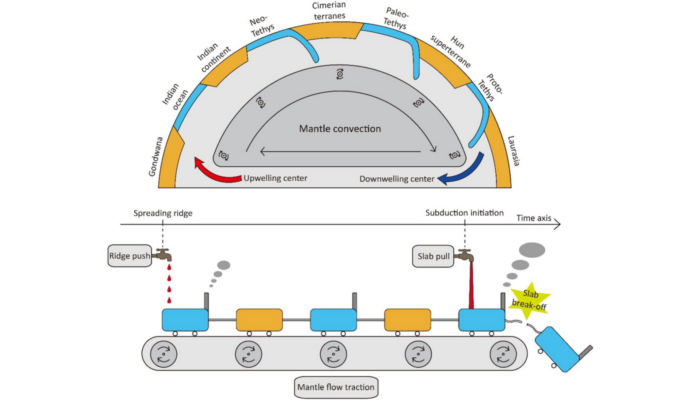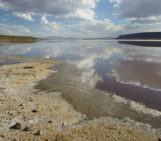
The highest mountain range in the Alps in the Western Europe, the towering peaks of the Himalayas in Asia, and ~1/3 world crude oil production in the middle east – what brings these remarkable nature gift together? The answer is Tethyan orogenic belt, which spans across the entire Eurasian continent. This week, we are privileged to have Prof. Zhong-Hai Li from the University of Chinese Academy of Sciences share his recent review work, addressing the key geodynamic processes and driving forces behind the evolution of the Tethyan region.
The Tethyan evolution history (Figure 1) is typically characterized by a series of ribbon-like (micro)continents that split from Gondwana and drifted northward to collide with Laurasia. Separated by continental margin terranes, such as the Hun Superterrane and Cimmerian terranes, the Tethys tectonic system can be divided into three stages, i.e., Proto-Tethys, Paleo-Tethys, and Neo-Tethys corresponding to the evolution of the Proto-Tethys, Paleo-Tethys, and Neo-Tethys oceans, respectively. These oceans closed successively with the continental margin terrane collision at different stages, eventually forming a series of age-progressive suture zones that grow older northward in the Tethys tectonic system.
 Figure 1. Key stages of Tethyan evolution (Li et al., 2023): (a) Proto-Tethys ocean; (b) Paleo-Tethys oceanic spreading; (c) subduction initiation (SI) of the Paleo-Tethys oceanic plate; (d) Paleo-Tethys Mid-Ocean Ridge (MOR) subduction; (e) Neo-Tethys oceanic spreading; (f) SI of the Neo-Tethys oceanic plate; (g) Neo-Tethys MOR subduction; (h) Indian oceanic spreading.
Figure 1. Key stages of Tethyan evolution (Li et al., 2023): (a) Proto-Tethys ocean; (b) Paleo-Tethys oceanic spreading; (c) subduction initiation (SI) of the Paleo-Tethys oceanic plate; (d) Paleo-Tethys Mid-Ocean Ridge (MOR) subduction; (e) Neo-Tethys oceanic spreading; (f) SI of the Neo-Tethys oceanic plate; (g) Neo-Tethys MOR subduction; (h) Indian oceanic spreading.
The Tethys tectonic system has experienced a long-term evolution history, including multiple Wilson cycles; thus, it is an ideal target for analyzing plate tectonics and geodynamics. Four key geodynamic issues play critical roles in the long-term and complex evolution of the Tethys tectonic system (Figure 2) and involve the mechanisms and driving forces of the (a) continental margin breakup and the onset of oceanic spreading, (b) terrane collision-induced SI and transference, (c) MOR subduction and tectonic regime transition, and (d) continental collision and plateau formation. These four geodynamic issues concentrate on the “birth”, “growth”, and “death” of an oceanic plate, which occur repeatedly during Tethyan evolution. Thus, the understanding of these geodynamic processes is of great significance to the knowledge of Tethys geodynamics and plate tectonics.
Figure 2. Four key geodynamic processes during Tethyan evolution (Li et al., 2023): (a) continental margin breakup and the onset of oceanic spreading; (b) terrane collision-induced SI and transference; (c) MOR subduction and tectonic regime transition; (d) continental collision and plateau formation.
Based on systematic numerical modeling studies, the dynamics of these four key processes have been constrained (Li et al., 2023; and references therein). Then, using the driving force as a principal line, these processes are linked together, forming a chain-like, unified model (Figure 3). Continental margin breakup leads to oceanic spreading and terrane drifting. After the terrane collision and accretion with the overriding continent, subduction transference may occur with the formation of a new subduction zone in the neighboring oceanic plate. After the MOR subduction, the subducting slab pull could be transmitted through the coherent oceanic plate to the northern margin of Gondwana, which may lead to the occurrence of a new continental margin breakup along the preexisting lithospheric weak zones or accompanied by the mantle plume activity.
In the long-term Tethyan evolution history, the northward ocean subduction drives the terrane drifting and oceanic spreading without any geodynamic difficulty. However, the slab pull may be insufficient or even absent in certain periods during the tectonic regime transition. A key bottleneck of the Tethys geodynamic process is the difficulty of SI or re-SI, including the aforementioned terrane collision-induced subduction transference and MOR subduction. The slab break-off generally occurs after the continental collision and ridge subduction, which means that slab pull could be considerably reduced or even lost during these periods (Figure 3). Thus, the progressive evolution of Tethys without the main driving force of the subducting slab pull is a puzzling issue. The systematic evaluation of driving forces (Li et al., 2023) indicates that the normal ridge push is insufficient for lithospheric collapse and SI. Meanwhile, the driving force generated by mantle plume upwelling may be limited because of the pointwise characteristic and short-term activity. The successive initiation of subduction zones during Tethyan evolution requires either decreasing the resistance force by lithospheric weakening or increasing the driving force or their combination. Based on the main Tethyan evolution characteristics of continuous and multistage northward plate convergence, a large-scale mantle flow should exist beneath the Tethys tectonic system, which generates a traction force on the overlying lithosphere. In the period when slab pull is absent, and ridge push is insufficient, the mantle flow traction may provide an additional driving force for the progressive Tethyan evolution, promoting the formation of new subduction zones and the recurrence of slab pull.
Figure 3. Conceptual illustration of the “multiengine-driving” (MED) model for Tethyan evolution (Li et al., 2023).
The entire process is defined as a “multiengine-driving” (MED) model (Figure 3). The main idea of the model is twofold: (a) during the normal subduction period, slab pull is the major driving force for the northward movements of Tethyan blocks; and (b) at certain transitional points between tectonic regimes without slab pull, such as terrane collision and MOR subduction, the mantle flow traction together with ridge push drives the (re)initiation of a new subduction zone and the recurrence of slab pull. The intermittent processes drive and maintain the continuous northward motion of the “Tethys train”. Therefore, a key element of the MED model is the long-term existence of a large-scale mantle flow in a fixed direction. Plate tectonic expression is the intermittent initiation and demise of subduction zones, causing the time-dependent variation of driving forces. Consequently, the kinematic velocity of plate motion should change with time, mainly corresponding to the variation of slab pull. This is a typical characteristic of the Tethyan evolution, e.g., the reconstruction-based convergence rate of the Indian continent varies considerably with time.
At the present stage of the Tethys tectonic system, a series of terranes is experiencing ongoing collision and accretion. As a period of insufficient slab pull, the driving force for continuous convergence is controversial and has been widely debated. In the framework of the MED model, the current period corresponds to a key stage of tectonic transition, i.e., terrane accretion and subduction transference (Figure 2b). At this time, because of the insufficiency of the driving force, the “Tethys train” moves slowly. With continuous stress accumulation from ridge push and mantle flow traction, subduction transference is expected to occur in the future. The possible initiation of a new subduction zone and the recurrence of slab pull will provide the major driving force for the progressive movement of the “Tethys train”.
Reference:
Li Z.H., Cui F., Yang S., Zhong X., (2023). Key geodynamic processes and driving forces of Tethyan evolution. Science China Earth Sciences, 66, 2666-2685. <https://doi.org/10.1007/s11430-022-1083-5>







Michael Pons
Really nice blog post! Do you have any idea what determines the size of the terranes?
Do we expect some inherited structures or large sutures zones to be reactivated during their formation?
cheers 🙂